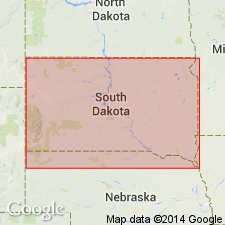
- Usage in publication:
-
- Irish Creek lithofacies
- Modifications:
-
- Named
- Reference
- Dominant lithology:
-
- Clay
- Silt
- AAPG geologic province:
-
- Williston basin
Summary:
Named as a westward facies and an informal division of Trail City Member of Upper Cretaceous Fox Hills Formation for in valley of Moreau River. Type section measured on south-facing cutbank and bluff north of river in center of sec 32, T15N, R21E, Ziebach Co, SD, Williston basin. Reference sections measured. Distinguished from Little Eagle (new), the eastern lithofacies of Trail City, by absence of fossiliferous concretions and thin clay and silt interbeds. Overlies Elk Butte Member of Pierre Shale. Upper part is equivalent to part of Timber Lake Member, Fox Hills. Underlies Iron Lightning Member (new) of Fox Hills (west exposures) and Timber Lake (east exposures). Cross sections; measured sections; nomenclature chart; facies maps. Exposed in northwest part of Grand River and its tributaries, west side Moreau River valley, south and southeast side Cheyenne-Moreau divide. Is 146+ ft thick at type where it consists of thinly interbedded and interlaminated, irregularly bedded and locally lenticular dark-gray clay and light-gray silt. Some beds sandy; some have rusty-brown weathering limestone concretions. A 1.2 ft thick bentonite bed 10 ft below top. Some jarosite. Fossil (mollusks) scarce. Of Late Cretaceous, Maestrichtian age.
Source: GNU records (USGS DDS-6; Denver GNULEX).
For more information, please contact Nancy Stamm, Geologic Names Committee Secretary.
Asterisk (*) indicates published by U.S. Geological Survey authors.
"No current usage" (†) implies that a name has been abandoned or has fallen into disuse. Former usage and, if known, replacement name given in parentheses ( ).
Slash (/) indicates name conflicts with nomenclatural guidelines (CSN, 1933; ACSN, 1961, 1970; NACSN, 1983, 2005, 2021). May be explained within brackets ([ ]).

